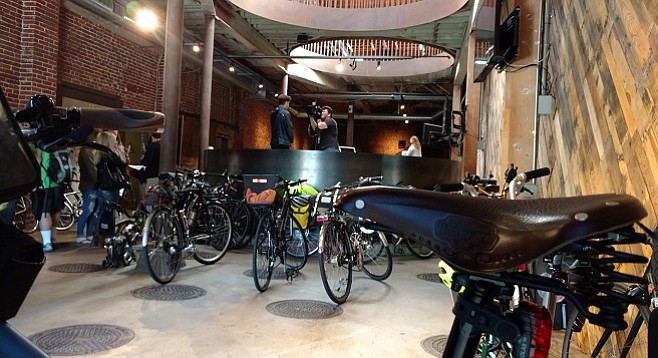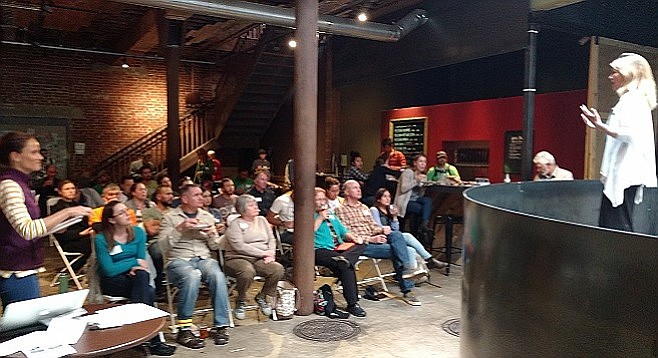 Facebook
Facebook
 X
X
 Instagram
Instagram
 TikTok
TikTok
 Youtube
Youtube

A crowd of about 50 cycling advocates from across the county packed into Mission Brewery downtown on Saturday morning (February 4) to learn about advocating for their cause: safer, expanded access to city streets for two-wheelers.
"This is our first advocacy training," explained Andy Hanshaw, executive director of the San Diego Bicycle Coalition. "It's about getting people excited and motivated to make change in their communities. But beyond just bicycles, it's about the process of advocacy — political, grassroots, the education process with the public."
Still, it's apparent the focus is on bike improvements, which have been a source of controversy. Community planning groups in neighborhoods such as City Heights and Little Italy have pushed back against the loss of parking to make way for safer bike lanes, and a feature published in the Reader last year critical of dedicating extensive land and money to cyclists resulted in a weeks-long flood of comments, as many from those opposed to bike-lane expansions as from those in favor. Progress, thus, has been slow.
"There's a lot happening — we have a $200 million program throughout the region to fund cycling improvements over the next eight to ten years," said Hanshaw. "That process is five years old now, and I don't think we're near where we need to be, so we really need to push [San Diego Association of Governments] to push these projects, to get them built, because a lot of what's slowing us down is the political process; people need to show support for these projects to give leadership confidence putting them in."

But enticing people out of their cars, said Climate Action Campaign founder Nicole Capretz, is critical if cities like San Diego are going to meet the ambitious goals laid out in their climate action plans.
"We're getting nowhere, basically," Capretz told attendees. "Even going to 100 percent clean energy — which we are, and it's great — won't get us to our goals unless we can get some of the people out of their cars."
While admitting that the San Diego region long has been and will likely remain car-centric, the city's climate plan has a goal of getting 50 percent of residents who live in well-served "transit corridors" (which make up only a fraction of the city's total area) to make their daily commute by means other than a single-occupant vehicle.
"Change is always hard, but this is change for the better. It's going to help us meet climate goals, it's going to ultimately ease transportation problems," said Hanshaw. "This is definitely an 'if you build it, they will come' scenario. We have evidence from all over the country and around the world that when safer bike lanes go in, the ridership goes up. And those types of bike lanes are coming."


A crowd of about 50 cycling advocates from across the county packed into Mission Brewery downtown on Saturday morning (February 4) to learn about advocating for their cause: safer, expanded access to city streets for two-wheelers.
"This is our first advocacy training," explained Andy Hanshaw, executive director of the San Diego Bicycle Coalition. "It's about getting people excited and motivated to make change in their communities. But beyond just bicycles, it's about the process of advocacy — political, grassroots, the education process with the public."
Still, it's apparent the focus is on bike improvements, which have been a source of controversy. Community planning groups in neighborhoods such as City Heights and Little Italy have pushed back against the loss of parking to make way for safer bike lanes, and a feature published in the Reader last year critical of dedicating extensive land and money to cyclists resulted in a weeks-long flood of comments, as many from those opposed to bike-lane expansions as from those in favor. Progress, thus, has been slow.
"There's a lot happening — we have a $200 million program throughout the region to fund cycling improvements over the next eight to ten years," said Hanshaw. "That process is five years old now, and I don't think we're near where we need to be, so we really need to push [San Diego Association of Governments] to push these projects, to get them built, because a lot of what's slowing us down is the political process; people need to show support for these projects to give leadership confidence putting them in."

But enticing people out of their cars, said Climate Action Campaign founder Nicole Capretz, is critical if cities like San Diego are going to meet the ambitious goals laid out in their climate action plans.
"We're getting nowhere, basically," Capretz told attendees. "Even going to 100 percent clean energy — which we are, and it's great — won't get us to our goals unless we can get some of the people out of their cars."
While admitting that the San Diego region long has been and will likely remain car-centric, the city's climate plan has a goal of getting 50 percent of residents who live in well-served "transit corridors" (which make up only a fraction of the city's total area) to make their daily commute by means other than a single-occupant vehicle.
"Change is always hard, but this is change for the better. It's going to help us meet climate goals, it's going to ultimately ease transportation problems," said Hanshaw. "This is definitely an 'if you build it, they will come' scenario. We have evidence from all over the country and around the world that when safer bike lanes go in, the ridership goes up. And those types of bike lanes are coming."
Comments